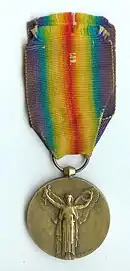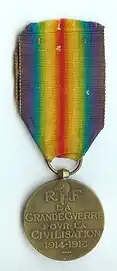| 1914–1918 Inter-Allied Victory medal (France) | |
|---|---|
  Obverse and reverse of the 1914–1918 Inter-Allied Victory medal | |
| Type | Commemorative Medal |
| Awarded for | Participation in World War I |
| Presented by | |
| Eligibility | Allied military forces, and attached civilians |
| Status | No longer awarded |
| Established | 20 July 1922 |
Ribbon of the 1914–1918 Inter-Allied Victory medal | |
| Precedence | |
| Next (higher) | Médaille commémorative du Maroc (1909) |
| Next (lower) | Médaille commémorative de la bataille de Verdun |
| Related | Médaille commémorative de la guerre 1914–1918 |
The 1914–1918 Inter-Allied Victory medal (French: "Médaille Interalliée de la Victoire 1914–1918") was a French commemorative medal established on 20 July 1922. It was the French version of a common allied campaign medal where each allied nation issued a Victory Medal to their own nationals, all issues having certain common features, including the same ribbon, a winged figure of victory on the obverse and a similar inscription on the reverse, the French version reading "LA GRANDE GVERRE POUR LA CIVILISATION 1914-1918".
It was awarded to all soldiers who served three months, consecutive or not, between 2 August 1914 and 11 November 1918 in the war zone. It was also awarded to civilian nurses, aliens (civilian or military) who served directly under French command, marshals and generals who had a command for at least three months, prisoners of war from Alsace and Lorraine who then served in the French forces. Article 10 of the establishing law states: "The right to the medal is also granted to soldiers who were killed by the enemy or died from wounds of war and those (....) who died of disease or injury incurred in service."[1] The next of kin of those killed or died were required to procure the medal at their own expense.[2]
International award
In response to a proposal first made by the French Marshal Ferdinand Foch, supreme commander of the Allied Forces during the First World War, most allied nations issued a Victory Medal following a common design, thereby avoiding any need for countries to exchange campaign medals.[3] Each country produced their own version, following certain common criteria. The medal was to be in bronze with a 36 mm diameter, having a winged figure of victory on the obverse, a common inscription on the reverse and suspension by a double rainbow design ribbon.[4] Japan and Siam replaced the figure of victory, since a winged victory symbol was not culturally relevant.[5]
The following versions were finally awarded:[6] At the start of the war in 1914, the countries of Poland and Czechoslovakia were parts of the Russian and Austro-Hungarian Empires respectively.
| Country | Designer | Manufacturer | Number issued |
|---|---|---|---|
| Belgium | Paul Du Bois (1859–1938) | Médailles d'Art Fonson & Cie | 300,000 – 350,000 |
| Brazil | Jorge Soubre (1890–1934) |
|
approximately 2,500 |
| Cuba | Charles Charles |
|
6,000 – 7,000 |
| Czechoslovakia | Otakar Španiel (1881–1955) |
|
approximately 89,500 |
| France | Pierre-Alexandre Morlon (1878–1951) |
|
approximately 2,000,000 |
| France[7] | Charles Charles |
|
----- |
| France[7] |
|
----- | ----- |
| Great Britain[8] | William McMillan (1887–1977) |
|
5,725,000 plus[9] |
| Greece | Henry-Eugène Nocq (1868–1944) |
|
approximately 200,000 |
| Italy | Gaetano Orsolini (1884–1954) |
|
approximately 2,000,000 |
| Japan[10] | Shoukichi Hata |
|
approximately 700,000 |
| Poland[11] | ... Vlaitov |
|
----- |
| Portugal | João Da Silva (1880–1960) |
|
approximately 100,000 |
| Romania | ... Kristesko | ----- | approximately 300,000 |
| Siam (Thailand) | Itthithepsan Kritakara (1890–1935) | ----- | approximately 1,500 |
| South Africa[12] | William McMillan (1887–1977) |
|
approximately 75,000 |
| United States | James Earle Fraser (1876–1953) |
|
approximately 2,500,000 |
(Main source : The interallied victory medals of world war I by Alexander J. Laslo, Dorado Publishing, Albuquerque. 1986 Edition )
Award certificate
A certificate confirming the award was given to each recipient confirming his right to wear the medal.

See also
- Allied Victory Medal
- French medals for the First World War
- Orient campaign medal: WWI French campaign medal for the Macedonian front
- Marne Medal: WWI French campaign medal for the First and Second Battles of the Marne
- Dardanelles campaign medal: WWI French campaign medal for the Gallipoli campaign
References
- ↑ Champenois, Marc (24 December 2011), "Médaille interalliée dite Médaille de la Victoire", France-phaleristique.com (in French), retrieved 6 June 2011
- ↑ Niels Stevnsborg. Three brothers, two casualties, one award. Orders & Medals Research Society Journal, December 2018, page 157.
- ↑ Captain H. Taprell Dorling. Ribbons and Medals. pp. 90–1. Published A.H.Baldwin & Sons, London. 1956.
- ↑ The Type I Victory Medal 1914-19. Richard Flory. Orders & Medals Research Society Journal, September 2009, page 145
- ↑ "Inter-allied Victory Medals". Retrieved 2018-07-09.
- ↑ "The interallied victory medals of World War I" by Alexander J. Laslo, Dorado Publishing, Albuquerque. 1986 Edition.
- 1 2 Unofficial type.
- ↑ Awarded not only to British combatants but as well to those from the dominions of Canada, Australia, New Zealand and those from the Empire of India.
- ↑ Joslin, Litherland and Simpkin. British Battles and Medals. pp. 231. Published Spink, London. 1988.
- ↑ On the obverse the winged figure of Victory was replaced by a warrior holding a spear.
- ↑ Poland did not proceed with the manufacture of the medal at their mint. The medal shows a clearly visible "MK" ( Mint Kremnica). The medal may be an unofficial strike by a veteran's group.
- ↑ The text on the reverse is in English and Dutch.